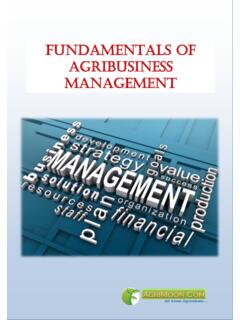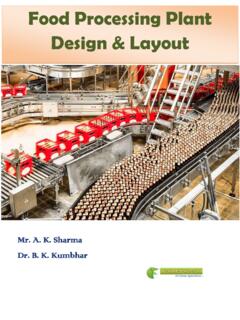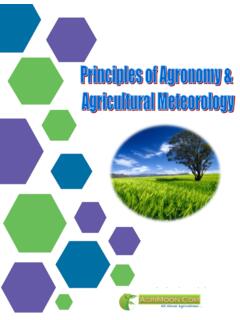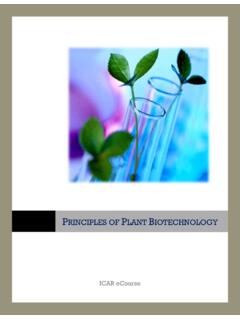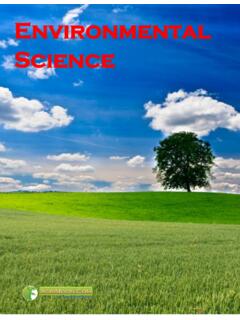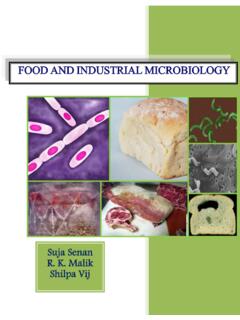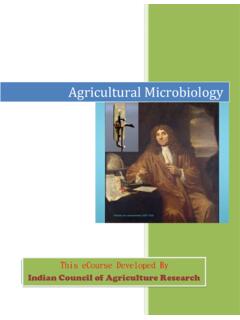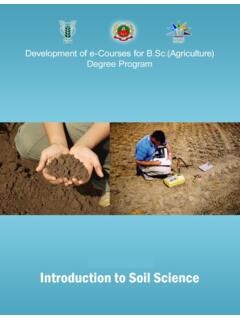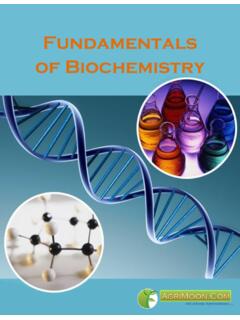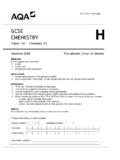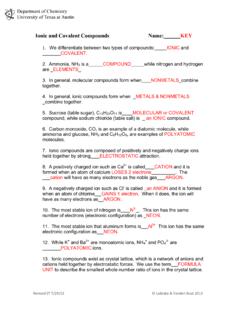Transcription of FOOD CHEMISTRY - AgriMoon
1 Satish Parmar Amit Kumar Jain K. D. Aparnathi food CHEMISTRY food CHEMISTRY Satish Parmar, Amit Kumar Jain & K. D. Aparnathi Department of Dairy CHEMISTRY & Biochemistry AAU, Anand Index L. No. Lesson Name Page No Module 1 Water Lesson 1 Structure of Water 5-9 Lesson 2 Water binding and chemical reactions mediated by water 10-23 Lesson 3 Determination of moisture in food 24-29 Module 2 food Proteins Lesson 4 Classification and physicochemical properties 30-34 Lesson 5 Reaction involved in processing and reactions with alkali 35-42 Lesson 6 Enzyme catalyzed reaction involving hydrolysis adn proteolysis 43-44 Lesson 7 Theories of formation of texturized proteins 45-47 Lesson 8 Edible fats and oils- Classification and chemical composition 48-52 Lesson 9 Reactions involved during deep frying of food 53-55 Lesson 10 Lipoprotein definition, classification and involvement in the formation of biological membranes 56-58 Module 4 food carbohydrates Lesson 11 Polysaccharide - linear.
2 Branched and modified 59-63 Lesson 12 Properties and utilization of common polysaccharides cellulose, glycogen, hemicelluolose, pectin, agar, alginate, carrageenan, gums and starch 64-74 Lesson 13 Enzymatic degradation of polysaccharides starch Production of dextrins and maltodextrins 75-76 Module 5 Minerals in food Lesson 14 Main elements and trace elements in eggs, cereals & cereal products, vegetables and fruits 77-81 Lesson 15 Hydrolases, lipases and other important enzymes in food 82-88 Lesson 16 Utilization in food industry and effect of inhibitors, pH and temperature 89-93 Module 7 food Additives Lesson 17 Vitamins, amino acids , minerals 94-98 Lesson 18 Aroma Compounds in food and flavor enhancers monosodium glutamate, nucleotides 99-102 Lesson 19 Sugar substitutes sorbitol, saccharin, cyclamate 103-105 Lesson 20 food Colours 106-110 Module 8 Antinutritional factors and food contaminant Lesson 21 Toxic trace elements, radionuclides 111-116 Lesson 22 Individual constituents proteins, lipids, carbohydrates and vitamins in cereals flour and their relationship in dough making 117-121 Lesson 23 Type of flours for bread making and confectionaries and influence of additives 122-125 Lesson 24 Physical, chemical changes during baking and determination of gluten and starch content in flour 126-130 Module 10 Legumes Lesson 25 Classification, composition and physicochemical properties 131-134 Lesson 26 Classification, general composition, chemical changes during ripening and storage 135-140 Module 12 Jams, Jellies and Pickles Lesson 27 Classification.
3 Composition and preservation 141-145 Module 13 Beverages Lesson 28 Classification, composition and gradation 146-151 Lesson 29A Chemical changes during processing Tea 152-157 Lesson 29B Chemical changes during processing coffee 158-163 Lesson 29C Chemical changes during processing Cocoa 164-167 Lesson 30 Determination of total ash, alkalinity of water soluble ash and water extractives in tea and detection of chicory in coffee powder 168-173 Module 14 Preservation of foods Lesson 31 General principles of food preservation-Physical methods 174-179 Lesson 32 Chemical preservation of food 180-183 Reference 184 food CHEMISTRY 5 Module 1 Water Lesson-1 Structure of water Introduction Water is relatively small inorganic molecule, but organic life is highly dependent on this tiny molecule. It is the only substance on the earth that occurs abundantly in all three physical states (gas, liquid and solid).
4 Water is essential for life: as: (1) regulator of body temperature (2) solvent (3) carrier of nutrients and waste products (4) reactant and reaction medium (5) lubricant and plasticizer (6) stabilizer of biopolymer conformation (7) facilitator of the dynamic behavior of macromolecules ( catalytic activity) Most of the fresh foods contain large amounts of water. It is one of the major component in composition of many foods. Each food has its own characteristic amount of this component. Effect of water on structure, appearance and taste of foods as well as their susceptibility to spoilage depends on its amount, location, and orientation. Therefore, it is essential to know its physical properties. Water has unusually high melting point, boiling point, surface tension, permittivity, heat capacity, and heat of phase transition values.
5 Other unusual attribute of water include expansion upon solidification, large thermal conductivity compared to those of other liquids, moderately large thermal conductivity of ice compared to those of other nonmetallic solids. Water Molecule Some the unusual properties of water are due strong intermolecular attractive forces among molecules of water. The unusual properties of water can be explained from nature of water molecules. In formation of water molecule, two hydrogen atoms form covalent bonds with oxygen. The highly electronegative oxygen of the water molecule pulls the single electron from each of the two covalently bonded hydrogen atoms towards its self, as a result each hydrogen atom becomes partially positively charged and oxygen becomes partially negatively charged. food CHEMISTRY 6 Consequently, resultant covalent bond formed between oxygen and hydrogen atoms acquires partial ionic character.
6 The bond angle of individual water molecule in vapor state is . Figure Structure of the water molecule Figure Hydrogen bonding of water molecules in a tetrahederal configuration food CHEMISTRY 7 Association of Water Molecules The shape of water molecule and the partial polar nature of the O-H bond in the water molecule create intermolecular attraction force. Such inter molecular attraction, results in to formation of hydrogen bonds between the water molecules. Therefore, water molecules associate with considerable tenacity. Figure Hydronium ion Each water molecule involves in four hydrogen bonds with neighboring water molecules. Multiple hydrogen bonding between water molecules, forms a structure of three-dimensional network. Figure Hydrogen bonding of water to two kinds of functional groups occurring in proteins food CHEMISTRY 8 Existence of three-dimensional hydrogen bonded structure of water is responsible for many of its unusual properties.
7 The extra energy needed to break intermolecular hydrogen bonds. This leads to large values for heat capacity, melting point, boiling point, surface tension, and enthalpies of various phase transitions of water. The dielectric constant (permittivity) of water is influenced by hydrogen bonding. Hydrogen-bonded multi-molecular dipoles increase the permittivity of water. The hydrogen bonded arrangement of water molecules is highly dynamic, allowing individual molecules to alter their hydrogen-bonding relationships with neighboring molecules. This phenomenon facilitates mobility and fluidity of water. The open, hydrogen-bonded, tetrahedral structure of water molecules in ice is responsible for low density of water in ice form. The extent of intermolecular hydrogen bonding among water molecules depends on temperature.
8 Figure Hydrogen bonding in ice food CHEMISTRY 9 Figure Unit cell of ordinary ice With input of heat melting of ice occurs; that is, some hydrogen bonds are broken distance between nearest neighbor increases. The latter factor predominates at temperatures between 0 and 4 C, which causes net increase in density. Further warming increasing distance between nearest neighbors (thermal expansion) predominates above 4 C, which causes net decrease in density. ** ** food CHEMISTRY 10 Module 1 Water Lesson-2 Water binding and chemical reactions mediated by water Introduction Mixing of solutes and water alters properties of each other. Hydrophilic solutes cause changes in structure and mobility of water and water causes changes in the reactivity, and structure, of hydrophilic solutes.
9 Hydrophobic groups of solutes interact only weakly with water. In interaction of solute with water, various bonding forces existing between water and solutes. To understand interaction between water and solutes at the molecular level, it is essential to knowledge about water-related phenomena and related terms like water binding, hydration, and water holding capacity. The terms water binding and hydration are often used to represent tendency of water to associate with hydrophilic substances in foods. The extent and tenacity of water binding or hydration depends on several factors like nature of solute, salt composition, pH, and temperature. Water holding capacity Term generally used to describe ability of a matrix of molecules to physically entrap large amounts of water in such a way that prevents exudation of the water.
10 The food matrices that entrap water in this manner include pectin and starch gels and tissue cells of plant and animal. This physically entrapped water does not flow from food even when they are cut or minced. But this water behaves almost like pure water during food processing operations like drying, freezing, etc. it is also available as a solvent. Thus, bulk flow of this water is restricted, but movement of individual molecules almost remains same as that of water molecules in a dilute solution. Impairment in this entrapment of water ( holding capacity) of foods has a significant effect on quality of food . Some of the typical examples are oozing out of liquid from gel (syneresis) and exudation of liquid on thawing of frozen foods. Bound Water Bound water is not a easily identifiable entity. It is poorly understood term. Number of definitions proposed.
